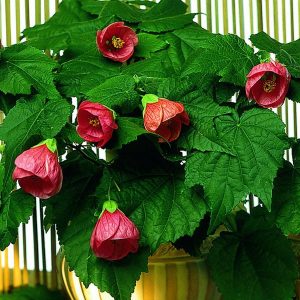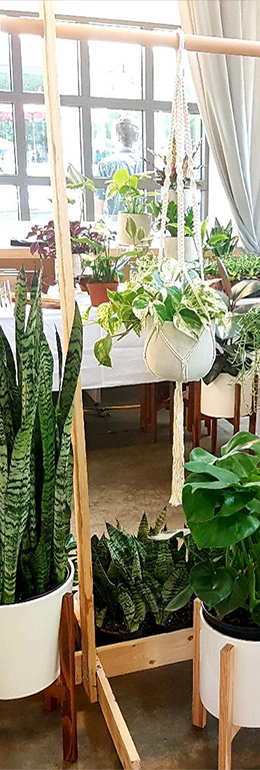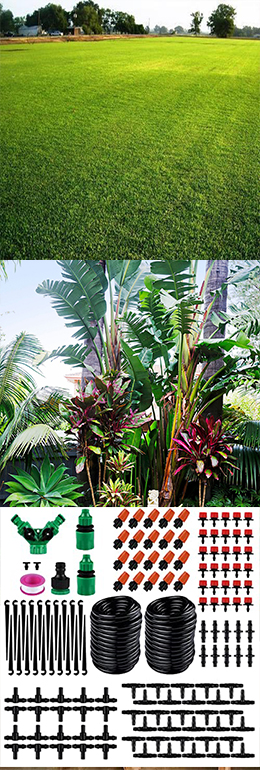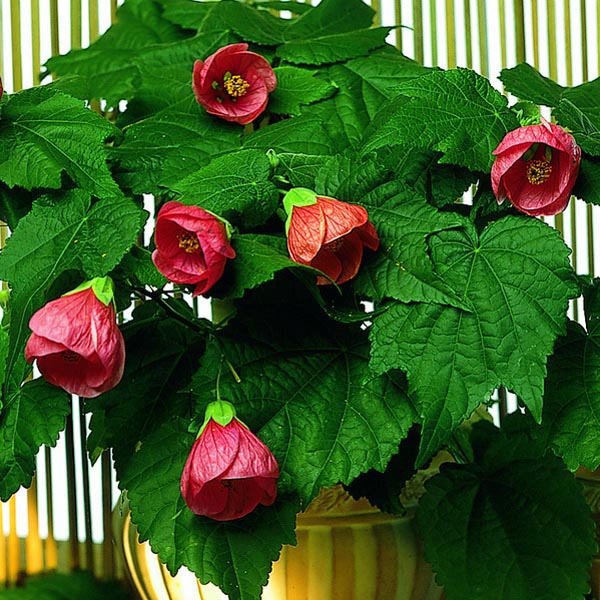Blooming Houseplants
Abutilon
FAMILY: MALVACEAE ORIGIN: BRAZIL
ABUTILON, FLOWERING MAPLE
ABUTILON IS CALLED FLOWERING MAPLE because of the shape of its broad, fivelobed
leaves, but it is in no way a maple. It is more closely related to the
hollyhock and to the weed known as velvet leaf. When given good light and
proper care, abutilon rewards its keeper by producing papery blossoms on
drooping stems nearly year-round. Flowers may be red, yellow, pink, orange, or
peach, depending on variety. Some varieties feature leaves mottled with yellow,
but the strongest growers have solid green leaves. Abutilon plants tend toward
legginess, so it is important to prune them back by one-third their size in the
spring, just before the most vigorous flush of new growth begins. Also pinch
back stems occasionally through the summer to promote a full, bushy shape.
Regular pruning makes it easy to keep an abutilon less than 18 in/45 cm high
and wide. If you want an upright plant to 36 in/1 m tall, tie long branches to
sturdy stakes.

SPECIFICATIONS
 |
Planting Difficulty | ★ |
|---|---|---|
 |
Temperature | Average to warm (65–80°F/18–27°C). Plant grows best when there is little difference between daytime and nighttime temperatures. |
 |
Soil Requirements | A peaty potting soil, such as African violet mix. |
 |
Watering | In spring and summer, water frequently to keep soil lightly moist. Leach pots once or twice in summer as described on page 263. In fall and winter, water less, but do not allow soil to dry out. Maintain moderate to high humidity. |
 |
Lighting |
Bright to moderate, with no direct sun.
|
 |
Propagation | When plant produces a new crown more than an inch away from the main one, gently pull it away when repotting plant and set it in a small container. With good care, it should begin blooming after about a year. |
 |
Pruning | Slight trim after blooming |
 |
Fertilization |
From spring through late summer, feed plants monthly
with a high-phosphorus plant food. In fall and winter, feed every 6 weeks with a balanced fertilizer. Newly purchased plants often have time-release fertilizer in the pot and need no feeding until plant is repotted. |
 |
Pest and Disease Control | Corner spot, red spiders, powdery mildew, scallops, rust |
TROUBLESHOOTING
Plant does not bloom.
CAUSE: Not enough light, or needs additional fertilizer.
REMEDY: Move plant to a place where it will get bright natural light half the day.
Switch to a high-phosphorous fertilizer. Some plants bloom very little in winter,
but vigorous hybrids should bloom year-round with good light and regular
feeding.
Flowers and low leaves drop.
CAUSE: Uneven watering, resulting in some roots remaining dry; too much direct
sun.
REMEDY: Rehydrate pot as described on page 328. In summer, move plant to a
place where it will be protected from hot midday and afternoon sun.
Sticky leaves; small insects present on leaves.
CAUSE: Aphids.
REMEDY: Prune plant to remove badly infested leaves. Clean thoroughly with
plenty of water every 3 days for 2 weeks.
Leaves are pale and stippled with yellow dots; faint webbing on leaf undersides.
CAUSE: Spider mites.
REMEDY: Isolate plant, and prune off and dispose of badly infested leaves. Clean
undersides of remaining leaves with warm, soapy water. Mist daily for a week
and see if plant shows signs of recovery. If plant has a stem that is not infested,
attempt to propagate its tip, because seriously damaged plants may not be worth
saving.

 العربية
العربية


